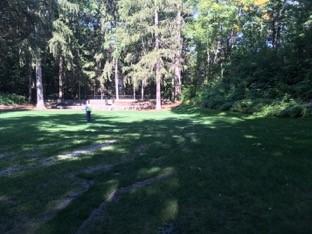
ABOVE Fig. 5. Alvin Lucier, "5 Graves to Cairo," 2017, site-specific underground sound installation, the Bema amphitheater, Dartmouth College, Hanover, New Hampshire. Photo by Spencer Topel.
Alvin Lucier: 5 Graves to Cairo
In a similarly phenomenological way to Swartz, the creations of Alvin Lucier often play on or exploit intrinsic aspects of human perception and acoustics. If there are visual components to his work, they function in the service of the sonic purpose. Interestingly, in the Resonant Spaces symposium on sound art, Lucier referenced the operational diagrams of Sol LeWitt as a way in which sound art might gain permanence relative to other forms of art that rely heavily on materiality. Sound art, in this model, is analogous to a musical composition, in the sense that it is scored for a particular situation, and not necessarily manifest as a material form. That is, rather than emphasizing the object, equipment, and tools for generating the art, the thing becomes instead the conceptual clarity, the instructions, the sound files, the blueprints, similar to those used in music and theater. For Lucier, this means that sound art can be a conceptual practice driven by instructions rather than a studio-based one. This is exactly how he developed a work for the Hood exhibition, where Lucier provided instructions to his assistant and to the museum on how his work was to be realized, much in the way an ensemble interprets and performs a composer’s manuscript.
In 5 Graves to Cairo (2017, fig. 5), sound is an additional layer to the already rich sonic environment of the Bema: a tree-lined grotto hidden in the middle of the Dartmouth campus, full of sounds from birds, trees moving in the breeze, industrial cooling systems from the adjacent science buildings, and various traffic sounds from nearby streets. In the process of installing the work, Lucier was insistent the low waves of droning sine tones would not dominate the ambient environmental sounds, but instead complemented them. It was important to Lucier that the rhythm and timing of the interferences between the different drones was slow enough so that each wave could be felt and experienced in between long silences. It was also vital to Lucier that the loudspeakers were hidden, buried beneath the ground. As he put it, “I didn’t want to disturb the visual beauty of the place by putting speakers on the lawn or in the trees.” Rather than draw attention to his acoustic intervention per se, Lucier instead encouraged visitors to experience his work within the visual and sonic qualities of the native environment. The influence from these ambient sounds varied greatly depending on the time of day, and even at larger seasonal timescales. For instance, when fall turned to winter, the sounds of the insects and birds were noticeably absent, making the sounds from the installation seem relatively louder by comparison. Lucier’s 5 Graves to Cairo thus not only speaks to a particular place, but also comments on how sound varies throughout natural cycles.
At a deeper level, Lucier’s 5 Graves to Cairo alludes to his father’s time at Dartmouth as a student, and how the artist imagined his parent moving about and participating in various activities on campus. The Bema in particular is a longtime fixture of the campus, formerly the site for graduations and other festive and ceremonial activities. To this end, Lucier ties into the deeper histories of both Hanover and his personal connections to Dartmouth.